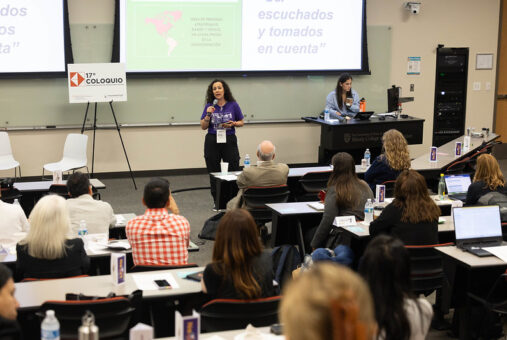Migrants are a vulnerable community with a great need for high-quality and reliable information. To meet this demand, media outlet Conexión Migrante was created.
The site was the topic of the panel “Journalism for the most vulnerable: Always listening: Migrant Assistance Center,” presented by Patricia Mercado, director of Conexión Migrante, during the 17th Ibero-American Colloquium on Digital Journalism.
During the panel, held at UT Austin on Sunday, April 14, 2024, Mercado described the history, mission, activities and challenges of Conexión Migrante, from its early days, to the execution of landmark journalistic projects and projects that go beyond journalism.

Patricia Mercado, director of Conexión Migrante, speaking at the 17th Ibero-American Colloquium on Digital Journalism, April 14, 2024 (Patricia Lim/Knight Center)
Initially designed to serve the Mexican and Latino community in the United States, the initiative has diversified and today offers information to Latin American immigrants in the U.S., migrants crossing Mexico and also those who have not yet arrived in the country.
“And what do migrants need? Well, a lot of things, but they need accurate information, they need verified data, real information that is easy to consult. Above all, being listened to and taken into account,” Mercado said.
According to the journalist, the website was created on Nov. 8, 2016, the same day that Donald Trump was elected president of the United States.
In 2023, Mercado said, Conexión Migrante had 3.3 million users and 5.5 million visitors. Of these, 40% were from the United States, 30% from Mexico and the rest from Latin America.
Furthermore, the site has a community with around 300,000 followers on Facebook, and another 75,000 on Whatsapp, divided into two channels: one for migrants who are in Mexico, and the other for immigrants who are in Mexico.
According to data that Mercado presented, there are 281 million migrants in the world. The Mexico-United States migration corridor is the largest in terms of accumulated volume in the world, with 10.9 million migrants in 2021. According to figures from the International Organization for Migration (IOM), in 2023, undocumented migrants in Mexico grew by 77%, she added.
The relationship between the media outlet and its community, said Mercado, is one of great trust. In addition to the journalistic team, Conexión Migrante also has a call center, designed to answer the community's questions.
“We have a very close relationship with the migrant community. It is a team at Conexión Migrante, first, very young, and second, that is at the service of the community – not only in the newsroom part, which is half of the team. The other half of the team are guys who are in the migrant service center, which is a call center where we receive between 800 and 1,000 calls, messages and communications monthly,” Mercado said.
This call center, which operates every day of the year, seeks to resolve queries from the community, but is also close to the newsroom. This means that journalists are constantly being told what is most important to migrants by people on the ground.
“So we are creating the content that migrants need at the moment they look for us. And what often happens is that the need of one person is the need of many. So we have created a wiki that is a search engine for procedures, advice and programs for the migrant community that allows them to have quick, easy, well-written, verified information that allows them to make better decisions,” Mercado said.
This telephone call center is important because migrants in general are people who are in a highly vulnerable situation and who others often try to deceive, Mercado said.
“In their journey, migrants are alone and highly vulnerable. And that vulnerability is also informative, since the networks are full of scammers and people who know how to deceive them. We are convinced that quality information for this community is essential to smooth out the immigration processes,” she said.
Mercado reported that, in 2023, Conexión Migrante participated in a survey together with five other outlets to try to identify the main factors of disinformation for the migrant community. In 10 days, the researchers got more than 250 people to respond to an 8-question survey. The results showed that 25% of those consulted had been victims of disinformation.
“Disinformation has become big business. It directly affects migrants, because it not only puts their personal safety at risk, but also their economic security. There are frauds that start at $5 and that are massive because thousands of people pay them. The largest ones that we detected were up to $20,000 to cross into the United States, and they regularly ended in abduction or extortion,” Mercado said.
The journalist stated that her media outlet is not interested in thinking about migration policies or reducing it, but only transmitting information to people, so that they are able to decide autonomously what to do, having access to data on destinations that offer better possibilities of integration and quality of life.
“We are not interested in stopping migration, we are not interested in orderly migration, it would be illogical to ask that of migrants. But we do believe that with quality information people will be able to make better decisions in their lives,” she said.
In conclusion, Mercado made a reflection that is at odds with those who condemn immigration, one of the main themes of the U.S. presidential campaign in 2024.
“Migration is not bad, it is simply a process that for the destination countries will always, always, always be good,” she said.
The Ibero-American Colloquium on Digital Journalism is an annual meeting of journalists from the region organized by the Knight Center for Journalism in the Americas. Traditionally it is celebrated on the Sunday following the closing of the International Symposium on Online Journalism (ISOJ) and this year it took place on April 14. A recording of the Colloquium can be found here.